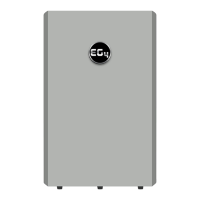PowerPro WallMount All Weather Installation Manual
33
11. Battery Charging
Charge cycle
Ensure the proper settings are set on the charge controller and/or inverter being used to avoid
overcharging or damaging the module. (Refer to Section 14.2: Technical Specifications Table for a full
list of charging/discharging parameters.)
Important (SOC Discrepancy)
It is normal for LFP batteries that have their own internal BMS and that are wired in parallel to
demonstrate a wide variety of SOC readings during any given charge or discharge cycle. Variations of
up to 10% are common. This is not cause for concern or indication that the module is providing less
than the maximum capacity. This is caused by even slight variations in wiring resistance to each battery,
internal resistance, temperature differences, and even variations in each cell. Even a slight variation
causes one battery to take more of the load or charge for a short time. Over the duration of the
discharge or charge cycle, this will balance out with the lagging battery then taking the load or charge at
the other end of the cycle resulting in recovering the full listed KWH capacity of the pack. The voltage
differences created as batteries diverge in SOC will eventually cause them to converge at some point in
the cycle.
12. Troubleshooting, Maintenance & Disposal
12.1 Introduction to the BMS
The BMS (Battery Management System) is intended to safeguard the battery and battery cells against a
variety of situations that could damage or destroy system components. This protection also aids in
keeping the battery and battery cells operational for a greater number of life cycles. Each EG4® battery
is specifically configured to ensure peak performance and operation with any system.
12.2 BMS Protection
PCB temperature protection
The BMS will ensure that the Printed Circuit Board (PCB) does not overheat. This is the part that
houses most of the “brains” of the battery. This feature will turn off the battery if it begins to overheat.

